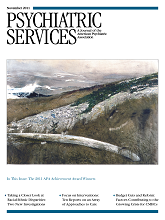A Randomized Controlled Comparison of Seclusion and Mechanical Restraint in Inpatient Settings
Abstract
Objective:
No evidence is available on the relative restrictiveness of seclusion and mechanical restraint, although guidelines recommend use of the least restrictive intervention. This study compared the restrictiveness of these interventions from patients' point of view.
Methods:
Data were collected from three general psychiatric admission units in South Germany. A total of 102 patients with schizophrenia, an affective disorder, or a personality disorder were included in a comprehensive cohort study with optional randomization. Restrictions of human rights as measured by the Coercion Experience Scale (CES) were the primary outcome variable. Possible total scores range from 1 to 5, with higher scores indicating a higher level of restriction.
Results:
Twenty-six patients were randomly assigned to seclusion (N=12) or mechanical restraint (N=14). A total of 76 were excluded from randomization and included in the cohort arms (48 experienced seclusion, and 28 experienced mechanical restraint). No difference in mean CES total scores was found between the randomly assigned patients after they experienced seclusion or mechanical restraint (seclusion median score=1.88 [range 1.24–4.24]; restraint median score=2.14 [range 1.28–4.00]). When randomly assigned patients and patients in the cohort arms were considered as a group, no significant difference in CES scores was found (seclusion median score=.40, [range 1.1–4.2]; restraint median score=2.59 [range 1.1–4.0]).
Conclusions:
The results do not provide evidence for using one intervention rather than the other. Clinical decisions should take into account patients' preferences. Randomized controlled trials of coercive interventions are feasible. Such studies contribute to the development of ethical and evidence-based guidelines. (Psychiatric Services 62:1310–1317, 2011)



